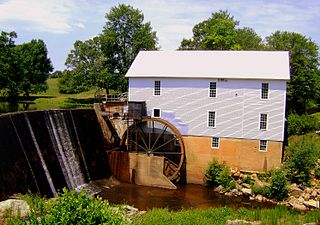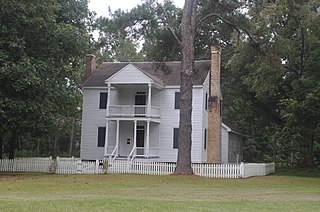
The Cedarock Historical Farm, located at Cedarock Park in Alamance County, North Carolina, provides an example of life on a farm in North Carolina during the 19th Century. Populated with farm animals, antique and replica farm equipment, and a farmhouse, the Historical Farm provides a fun, education stop while visiting Cedarock Park.

The Inns on the National Road is a national historic district near Cumberland, Allegany County, Maryland. It originally consisted of 11 Maryland inns on the National Road and located in Allegany and Garrett counties. Those that remain stand as the physical remains of the almost-legendary hospitality offered on this well-traveled route to the west.

The Strickland Road Historic District of Greenwich, Connecticut is a 9-acre (3.6 ha) historic district that was listed on the U.S. National Register of Historic Places in 1990. The district extends along Strickland Road in the Cos Cob section of Greenwich, between its junction River Road in the south, to just north of its junction with Loughlin Road in the north. It represents a well-preserved cross-section of residential architecture dating coverint a 200-year period, from about 1740 to 1934. It includes the c. 1730 Bush-Holley House, a historic house museum which is a National Historic Landmark for it role in the Cos Cob art colony. There are 28 primary contributing buildings in the district. Most of the buildings are wood frame structures between one and three stories in height; the notable exceptions are two of the later houses, which are Tudor Revival in style and have brick and stucco exteriors.

Jervis Gordon Grist Mill Historic District, also known as Milford Grist Mill and Rowe's Mill, is a historic grist mill and national historic district located at Milford, Pike County, Pennsylvania. The district includes three contributing buildings and one contributing structure. The buildings are a late-19th century grist mill, blacksmith complex, and millers house. The contributing structure consists of the mill pond, dam, head race, and tail race.

Greenbank Historic Area is a historic grist mill located at Marshallton, New Castle County, Delaware. The property includes the Greenbank Mill, Robert Philips House, and the W. G. Philips House. The mill was built in 1790 and expanded in 1812. It is a 2 1⁄2 story, frame structure with a stone wing. The mill measures 50 feet (15 m) by 39 feet (12 m). The Robert Philips House was built in 1783, and is a 2 1⁄2 story, five bay, stone dwelling with a gable roof. The front facade features a long verandah. The W. G. Philips House, also known as the mill owner's house, dates to the mid-19th century. It consists of a two-story, three bay front section with a three-story, hipped roof rear section. Oliver Evans, a native of nearby Newport, installed his automatic mill machinery in the 1790 building.

The Samuel Cox House is a historic house located near Scottville, Ashe County, North Carolina. It is a "T"-plan dwelling consisting of a two-story log, gable roof, main section built in the mid-19th century, with a later one-story frame ell and frame addition on the east side of the ell. The log section was covered with weatherboards about 1880. The front facade features a one-story, full-width shed-roof porch.

Murray's Mill Historic District is a national historic district located near Catawba, Catawba County, North Carolina. The district encompasses 20+ contributing buildings near the rural Town of Catawba. It contains the mill buildings, four residences and complementing structures associated with the milling operations and the Murray family. They were built between the 1880s and mid-20th century. Notable buildings include the large two-story frame mill (1912-1913), store building, wheathouse (1880s), John L. Murray House (1913), a large gable roof frame barn (1930s), Lloyd Murray House (1935), and William Murray House (1880s).

Dr. E. H. Ward Farm is a historic home and farm located near Bynum, Chatham County, North Carolina. The main house was built in sections during the mid-19th through early-20th century beginning about 1840. The earliest section is a 1 1/2-story, gable-roofed, two room log structure, that forms the rear of the main section. The main section was built about 1870, and is a one-story, gable-roofed frame structure with a simple gable-front porch. A one-story board-and-batten rear ell was added about 1900. Also on the property are the contributing office of Dr. Ward, carriage house and gear room, board-and-batten barn and log cribs, smokehouse and pen, and a small brick well house.

Strawberry Hill is a historic plantation house located in Edenton, North Carolina, and owned by William and Laurie Raucci. The original section was built about 1788 in a Georgian/Federal style then enlarged to its present size in the early- to mid-19th century. It is a two-story, frame dwelling with a center hall plan. The front facade features a two-tiered, full-length porch. The original portion of the house was built by Congressman Charles Johnson.

Reid Farm is a historic home and farm located near Jackson Hill, Davidson County, North Carolina. The main house is a two-story, four bay, vernacular Greek Revival style farmhouse. Also on the property are a massive threshing barn and a full complement of log and frame outbuildings dating from the mid-19th through the early-20th centuries. The buildings have been moved to Denton Farmpark.

Oakland Plantation, also known as Lloyd Farm and the Elks Lodge, is a historic plantation house located at Tarboro, Edgecombe County, North Carolina. The frame dwelling dates to the mid-19th century, and consists of a two-story central section with flanking one-story wings and a series of rear additions. It has shallow hip roofs with Italianate brackets and features a one-story porch of the distinctive Tarboro lattice type. By 1931, the dwelling was occupied as an Elks Lodge for the African-American population.

Clifton House and Mill Site is a historic home and grist mill site located near Royal, Franklin County, North Carolina. It was built in the 1850s, and is a two-story, rectangular frame house with a hipped roof in the Greek Revival style with Italianate design elements. It features a two-story pedimented front porch and has a two-story rear ell. Also on the property are two contributing 19th-century outbuildings, Miller's House, and the ruins of a grist mill built about 1831, including some machinery.

Freeman House, also known as The Stateline House, is a historic home located on the North Carolina-Virginia state line near Gates, Gates County, North Carolina, USA. The house was built in three building phases, the earliest perhaps dating to the late-18th century. The farmhouse was initially built following the basic early-Federal-style one-room plan, followed by the addition of a late-Federal-style two-story side-hall-plan, which was finally enlarged and converted in the mid-19th century to a more substantial Greek Revival style, center-hall-plan dwelling. The main section is a two-story, five bay, frame structure. Also on the property are the contributing smokehouse, a kitchen with exterior end chimney, a one-story tack house with an attached wood shed, a small, unidentified shed, two large barns, and a stable.

Woodstock is a historic plantation house located near Scotland Neck, Halifax County, North Carolina. The earliest section dates to about 1783, and is a two-story, vernacular frame dwelling with later rear additions. It was expanded in the mid-19th century to a romantic villa house three bays wide and two large bays deep with a shallow gable roof and one-story full-width front porch. The house is set in a formal landscape designed by Joseph B. Cheshire.

Mill Prong is a historic plantation house located near Edinburgh, Hoke County, North Carolina. The main section was built about 1772, and is a two-story, three bay, Federal frame dwelling. It is sheathed in weatherboard and has a gable roof. It features a center bay, two-tier front porch. It was enlarged in the 1830s and in the fourth quarter of the 19th century. Also on the property is the contributing McEachern family cemetery.

Green River Plantation is a historic plantation house on over 360 acres located near Columbus, Polk County, North Carolina. The oldest section of the "Big House" was built between the years 1804-1807, and is a two-story, four bay, Late Federal style frame dwelling. A later two-story, four bay, brick Greek Revival style dwelling was built beside the original structure in the mid-19th century. The two sections were joined in the late 19th century by a two-story section and grand staircase to form a structure that is over 10,000 square feet in size and boasts over 42 rooms and spaces. The plantation house was built by Joseph McDowell Carson, son of Col. John Carson, who built Carson House at Marion, North Carolina. The later-built section of the home was the residence of Samuel Price Carson, North Carolina State Senator and U.S. Federal Representative, and younger brother of Joseph McDowell Carson.

Dempsey-Reynolds-Taylor House is a historic home located at Eden, Rockingham County, North Carolina. The original section dates to the early-19th century, and consists of a two-story, Federal style frame block with an attached 1 1/2-story brick section. It was enlarged by an Italianate / Queen Anne style main block added in the late-19th century. Later additions to the house occurred in the 1920s.

Ashland is a historic plantation house located near Henderson, Vance County, North Carolina. It consists of two sections dated to the late-18th and mid-19th centuries. The older section is a two-story, two bay, frame section attached to the newer and taller two-story, three bay frame section. Each section is sheathed in weatherboard and topped by gable roofs. The house displays elements of Federal and Greek Revival style architecture. Judge and colonizer Richard Henderson (1734–1785) owned the Ashland tract among his vast holdings.

Williamson Page House is a historic home located at Morrisville, Wake County, North Carolina. It is a two-story, three-bay-wide, frame I-house. The front section was built about 1838, with a transverse stair hall added about 1876, which connects the front section with a two-story rear ell dated to the mid-19th century. The front section has a side gable roof and one-story hipped-roof porch with jig sawn spandrels and a flat balustrade.

The Dexter Grist Mill, now the Dexter Historical Society Museum, is a historic 19th-century industrial property in Dexter, Maine. Built in 1854, the mill was operated by a single family for over a century, and was converted to a museum in 1967. It was listed on the National Register of Historic Places in 1975.





















